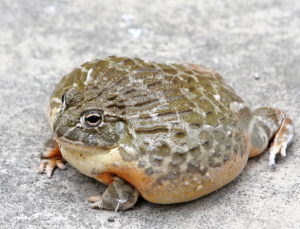African bullfrogs are also known as giant bullfrogs because they are the largest amphibians living in South Africa, reaching 2 kilograms (kg) in weight and 20-25 centimeters (cm) in length for males; females only reach half that size. This is one of the few species of frogs and toads where the males are larger than the females.
They have been kept as pets for quite a while. The African bullfrog is a food item for the locals, but it contains a poison called “Oshiketakata.” This type of poison can cause kidney failure and death when ingested in large enough amounts. To neutralize this poison, the locals cook the pyxie frog in a pot lined with dry
wood. The pyxie frog also makes for very good low-maintenance pets, and are available in the pet trade in low numbers that are not likely to affect the wild population too much. As a defense mechanism, in order to look larger when threatened, the African bullfrog is able to inflate itself like a balloon.
The giant and the dwarfAfrican bullfrogs are also called Pyxie frogs because of their genus. There are two types: the giant (P. adspersus) and the dwarf (P. edulis). Giant bullfrogs are found mainly in the sub-Saharan territories in North and East into Somalia, West to Nigeria and South Africa, while the dwarf African bullfrog can be found in fewer areas in South Africa, mainly Zimbabwe and probably in other neighboring countries such as Botswana, Mozambique, and Zambia.
Now, if you are considering getting a pyxie frog for a pet, remember to ask the seller about the origin of the animal so you have an idea as to which one you are probably going to receive from them. The size difference is really evident, so there will definitely be different housing requirements for these two species. Though in some areas their territories overlap, it is better to know the animal’s origin so as to better identify its species.
Habitat – As a terrestrial and freshwater-dwelling amphibian, African Bullfrogs hibernate in drier savannahs when environmental conditions aren’t favorable for them. They emerge during the start of the rainy season—which also signals the beginning of their breeding season—to breed in temporary bodies of water. They are diurnal (active during the day) during the breeding season.
They can remain dormant for 10 months, and this can stretch up to 2 years if conditions are not yet favorable for breeding. In the Philippines, the African bullfrog is put in a terrarium with an adequate amount of cocopeat as a substrate for burrowing; this is moistened to prevent long periods of unnecessary hibernation.
Diet – The Pyxicephalus adspersus is a carnivorous species preying on animals the same size as they are or smaller than them. They should be kept individually because they have a tendency to prey on one another when kept together, and the smaller ones will surely get eaten first.

They can eat a variety of creatures such as locusts, worms, crickets, and roaches. Don’t be surprised if they prey on small mammals, birds, reptiles, and amphibians, among others. In captivity, they are fed with roaches, worms, mice, or rats, which are readily available on the market. These prey creatures should be well fed before being served to the Pyxicephalus adspersus for better nutritional value.
Breeding – The African bullfrog reaches maturity at about 1.5 to 2 years of age. During the breeding season, African bullfrogs assemble in large groups in and around temporary bodies of water. Males tend to get more aggressive as they compete for the females for breeding.
The female African bullfrog can lay up to 4,000 eggs in one breeding season and the male protects the offspring up to 3 weeks. However, not all of the fertilized eggs survive to adulthood because they are eaten by natural predators in the area, mainly birds, Nile monitor lizards, turtles, diver ants, mammals, and even humans.
Economic Importance – The Pyxicephalus adspersus is generally beneficial for humans. The meat is prepared and served as food in Africa. Pyxie frogs are also sold in the local and international pet trade for the monetary benefit of the locals in Africa, though not in numbers that can damage the local population.
However, because of human intervention, they have been introduced to other habitats where they don’t normally occur and can eventually be damaging for the ecosystem in that area since they don’t have natural predators in the place they were introduced to. The long-term effects can be detrimental, but since they serve as a food source, the effects may be mitigated by human intervention.
Conservation status – Based on the published 2013 data of the International Union for Conservation of Nature (IUCN) the pyxie frog is under the category “least concern,” which means that there are no efforts currently being undertaken to preserve the species, and they are not at risk of extinction.
The main threat to Pyxicephalus adspersus is habitat loss due to urbanization. With an increasing human population, the habitats of animals overlap with human territories, which can lead to conflict or elimination of the animal. The African Bullfrog also occurs naturally in some protected areas.
This story appeared in Animal Scene’s July 2016 issue.






